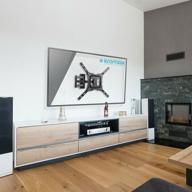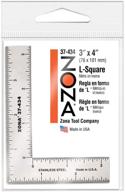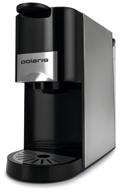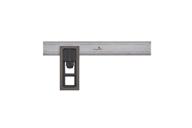Top products in 📐 Carpentry Squares
How to check a floor for levelness with a Johnson Level carpentry square
Having a perfectly level floor is crucial for many home improvement and construction projects. An uneven floor can cause problems when installing wood or tile flooring, cabinets, and more. Using a high-quality carpentry square like the Johnson Level Tool CS2 16 Inch model is an easy way to check for levelness across your floor.
What you'll need:
- Johnson Level carpentry square
- Tape measure
- Pencil
- Notepad
Instructions:
- Start in one corner of the room and place the carpentry square flush against both walls. Use the pencil to mark the floor at the corner of the square.
- Measure out several feet and make another pencil mark where you place the square.
- Place the square at the new location and check if it sits flush against the floor. Look for gaps between the square's edges and the floor.
- If there is a gap, measure the gap with the tape measure and record the difference on your notepad, along with the location in the room.
- Continue taking measurements every few feet across the entire floor in a grid pattern.
- Review your measurements. Any differences over 1/8 inch across the floor could cause problems in flooring installation or other projects.
Be thorough in your measurements - uneven spots can occur anywhere. Look for patterns like one corner being higher than the rest. If the floor is very uneven, you may need to use floor leveling compounds before installing floor coverings.
With detailed measurements and the Johnson Level square, you can identify any problem areas and correct them to get your floor perfectly flat for your project.
How to mark perfect right angles on wood with a Johnson Level
Correctly marking right angles is vital for woodworking and carpentry projects. Using a high-quality square like the Johnson Level CS2 ensures accurate 90 degree angles every time.
What you'll need:
- Johnson Level square
- Pencil
- Safety glasses
Instructions:
- Put on safety glasses to protect your eyes from wood splinters.
- Place the square flush against the wood on adjacent edges. Double check it's fitting tightly with no gaps.
- Hold the square firmly in place with one hand. With your other hand, make a pencil mark along the inside of the square's edge. Mark the line across the entire edge of the wood.
- Without moving the square, repeat the pencil mark on the adjacent edge for a perfect 90 degree cross mark.
- Make additional marks further inward from the edge to create a clear right angle for cutting or drilling.
- For longer boards, mark increments every several inches to maintain the accuracy across the entire board.
- Flip the square to the other side and repeat the marks to verify accuracy.
Tips:
- Use a combination square for marking inside corners or in tight spaces.
- Keep a cut-off wood scrap under the square on painted or slippery surfaces.
- Mark which side is up on your square to ensure consistency.
With a quality square like the Johnson Level tool, you can create flawless right-angled woodwork. Taking the time to correctly mark angles will lead to stronger finished products.
Another interesting products
How to align cabinets using a Johnson Level Tool square
Proper cabinet alignment is crucial for both function and aesthetics in your kitchen or bathroom. Using a trusted carpentry square like the Johnson Level Tool CS2 ensures your cabinets are perfectly positioned.
What you'll need:
- Johnson Level square
- Pencil
- Tape measure
- Drill
Instructions:
- Mark the cabinet height from the floor on the wall using your Johnson square and pencil. Use a level to ensure it's perfectly horizontal.
- Also mark a vertical plumb line for the first cabinet's edge location using the square.
- Use the marks to brace and attach a ledger board for the cabinets to sit on. Keep it precisely leveled and lined up.
- Place the first cabinet on the ledger board, flush against the vertical line. Use shims to fill any gaps.
- Use the Johnson square placed against the front cabinet edge and wall to mark the back edge location.
- Drill pilot holes and fasten through the back frame into the wall studs to secure the cabinet.
- For additional cabinets, use the square to transfer the plumb line mark down the wall to align the fronts.
- Verify each cabinet is leveled as you work your way across the wall.
Tips for alignment success:
- Use filler strips if your wall is uneven.
- Provide ventilation space between cabinet and wall.
- Use spare wood to prop cabinets as you attach them.
Investing a few extra minutes in careful alignment using a Johnson Level square will give you professional-looking cabinet installations that function properly for years to come.
How to make shelves using a Johnson Level square for accuracy
Perfectly straight, level shelves rely on precise measuring and cutting. Using a quality carpentry square like the Johnson Level Tool CS2 model ensures accuracy.
What you'll need:
- Johnson Level square
- Pencil
- Circular saw or table saw
- Drill
- Shelf brackets
Instructions:
- Measure the area where the shelf will be installed. Account for the size of the brackets when calculating the length of boards needed.
- Cut the shelf boards to length. Place the Johnson square against the edge of the board to mark with pencil where cuts should be made for straight edges.
- Mark bracket locations on the wall using the Johnson Level square to create horizontal level lines. Use a stud finder to position over studs.
- Hold each shelf board against the wall in the desired shelf location. Use the square to mark drill points for the bracket screws by aligning the square's edge to the pencil lines.
- Drill pilot holes at the marked bracket points. Attach the shelf brackets securely into the studs.
- Set the shelf board onto the brackets, keeping the edges aligned with the horizontal level lines. Attach securely using screws through the bracket holes.
- For multiple shelves, repeat the process using the original level lines for consistent spacing and alignment.
Tips for sturdy shelves:
- Use at least 1 inch thick boards for the shelves.
- Pre-drill holes slightly smaller than screw diameter.
- Use finish nails through brackets for added strength.
With care and the trusted accuracy of a Johnson Level square, you can create strong, professional-looking shelves that will last for many years.
Similar products
How to lay tile perfectly straight with a Johnson Level CS2 square
Achieving perfectly straight tile layouts relies on proper planning and precision tools. The Johnson Level CS2 square provides the accuracy needed for flawless tile installations.
What you'll need:
- Johnson Level CS2 square
- Tile spacers
- Tile cutter
- Tile adhesive
Instructions:
- Mark the midpoint of each wall with the Johnson square and a pencil. Use the horizontal and vertical markings to establish your starting point.
- Dry lay the first tile in one corner of the room aligned with the marks. Place spacers against each edge.
- Continue dry laying tiles in rows along the horizontal line, using spacers to set consistent gaps.
- When you reach the first corner, use the Johnson square to ensure the vertical edge lines up precisely. Adjust as needed.
- Continue dry laying until you fill the room, checking alignment with the square every few rows.
- Make any cuts needed using the tile cutter. The Johnson square can mark straight cut lines.
- Once satisfied with the dry run, apply adhesive and install the tiles permanently using the same layout.
Tips for straight success:
- Double check room measurements to calculate tile layout.
- Use wedges to keep tiles aligned during drying.
- Let adhesive fully cure before grouting (usually 24-48 hours).
Careful prep and using a precise square like the Johnson Level CS2 will lead to beautiful, professional tile installations.
How to check if a wall is plumb using a Johnson Level 16 inch square
Verifying the plumb or vertical straightness of a wall is important before installing trim, tile, cabinets, and more. The Johnson Level 16" square is an ideal tool for checking plumb.
What you'll need:
- Johnson Level 16" square
- Pencil
- Tape measure
- 4 foot level (optional)
Instructions:
- Start by measuring up from the floor at one end of the wall and making a pencil line where you want to check for plumb.
- Place the Johnson square's vertical edge right at that pencil mark. Hold the square securely against the wall and top of the line.
- With the square edge aligned vertically, examine the opposite edge. Look for gaps between the square and wall along the top and bottom of the square.
- If the edge isn't flush, measure any gaps with the tape measure. Make note of the difference and location.
- Move down a few feet and recheck, repeating the process every few feet down the entire wall length.
- For thoroughness, flip the square and recheck measurements in the same spots.
- Optionally, double check your results using a 4 foot level in the same locations.
Any measurement variations beyond 1/8 inch over several feet could indicate plumb issues requiring correction before further installation. Use shims or furring strips to correct bowing or leaning walls before projects like tiling or paneling.






















